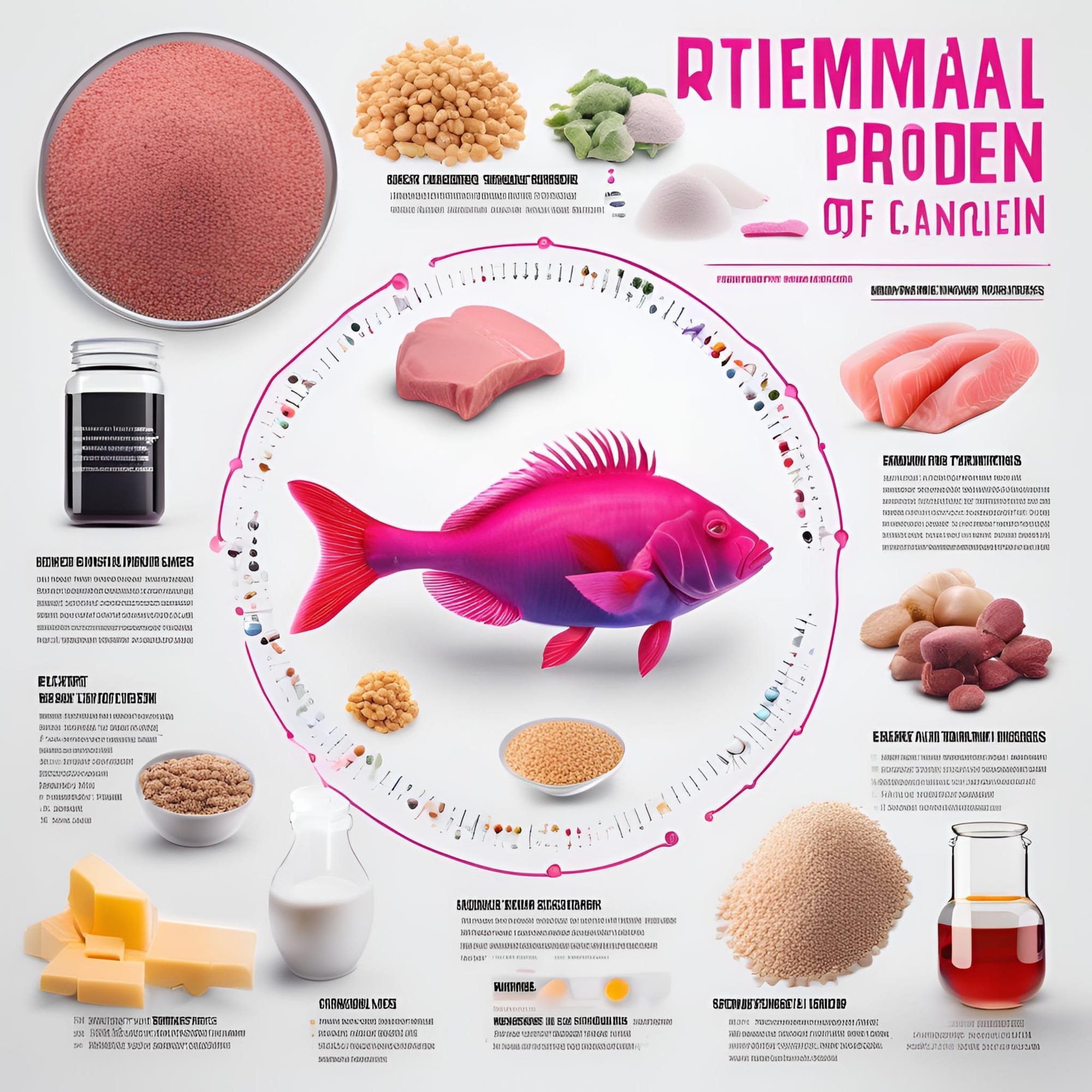"Exploring Alternatives: Chemicals and Innovations for Achieving 100 Grams of Equivalent Animal Protein"










buymeacoffee.com coming soon..
Introduction to Animal Protein and Its Importance
Animal protein is a fundamental component of the human diet, renowned for its rich array of essential nutrients and high biological value. Defined as protein derived from animal sources, it encompasses a wide variety of foods, including meat, poultry, fish, dairy products, and eggs. These sources not only provide an abundance of protein but also offer a complete amino acid profile crucial for various bodily functions, such as muscle repair, enzyme production, and immune system support.
The nutritional value of animal protein is significant. It is packed with vital nutrients such as iron, zinc, and B vitamins, particularly B12, which are often less accessible in plant-based foods. For many individuals, animal protein serves as a primary source of energy and sustenance, contributing to a balanced diet that supports overall health and well-being. Research consistently demonstrates that adequate protein intake can enhance muscle mass, improve metabolic health, and aid in weight management, making it an essential nutrient for individuals of all ages.
However, the increasing global population and rising demand for animal protein have created challenges regarding sustainability and environmental impact. Traditional animal farming practices are often resource-intensive, leading to concerns about greenhouse gas emissions, land degradation, and water usage. Consequently, there is a growing need for alternatives to traditional animal protein sources that can meet dietary needs while also addressing these environmental concerns. This has sparked interest in exploring plant-based proteins, synthetic alternatives, and innovative chemical supplements that can replicate the benefits of animal protein without the associated drawbacks.
In the following sections, we will delve deeper into these alternatives, examining their nutritional profiles, benefits, and the challenges they present in the quest for sustainable protein sources.
Plant-Based Proteins as Alternatives
As the demand for sustainable and ethical food sources continues to rise, plant-based proteins have emerged as a viable alternative to traditional animal protein. This section will explore the various types of plant proteins, their amino acid profiles, conversion ratios in terms of protein equivalence, and the benefits and challenges associated with their use.
Types of Plant Proteins and Their Amino Acid Profiles
Plant proteins are derived from various sources, including legumes, grains, seeds, nuts, and vegetables. Some of the most common plant protein sources include:
- Legumes: Beans, lentils, and peas are rich in protein and provide essential nutrients. For instance, cooked lentils contain approximately 9 grams of protein per 100 grams, along with a good range of vitamins and minerals.
- Grains: Quinoa, brown rice, and oats contribute significant protein content. Quinoa stands out as a complete protein, offering all nine essential amino acids, while other grains may lack one or more of these critical components.
- Seeds and Nuts: Chia seeds, flaxseeds, almonds, and walnuts not only provide healthy fats but also deliver a substantial amount of protein. For example, 100 grams of chia seeds contain about 17 grams of protein.
- Vegetables: While often lower in protein compared to legumes and grains, certain vegetables like spinach and broccoli still contribute to overall protein intake. For instance, cooked spinach offers around 3 grams of protein per 100 grams.
The amino acid profiles of these plant sources vary, with some being complete proteins (like quinoa and soy) and others being incomplete, requiring complementary sources to provide a full spectrum of essential amino acids.
Conversion Ratios of Plant Protein to Animal Protein Equivalence
When evaluating the efficacy of plant proteins as alternatives to animal proteins, it is important to consider conversion ratios. This measurement indicates how much plant protein is needed to equate to a specific quantity of animal protein.
Research suggests that the biological value (BV) and protein digestibility-corrected amino acid score (PDCAAS) can help quantify the quality of protein from both sources. For instance, animal proteins typically have a higher BV and PDCAAS than most plant proteins. Consequently, one might need to consume between 1.5 to 2 times the amount of plant protein to achieve the equivalent protein quality and quantity found in animal sources.
This conversion highlights the importance of consuming a variety of plant proteins to ensure a complete amino acid profile. For example, pairing legumes with grains—such as rice and beans—can enhance the overall protein quality.
Benefits and Challenges of Using Plant Proteins
The shift towards plant-based proteins comes with several benefits. Firstly, plant proteins are generally lower in saturated fats and cholesterol, making them a heart-healthy option. Secondly, they contribute to a decreased carbon footprint and reduced resource consumption compared to animal farming, addressing environmental concerns related to livestock production.
Moreover, plant proteins are often rich in fiber, vitamins, and antioxidants, which contribute to overall health and wellness. As consumers become more health-conscious, incorporating plant proteins into their diets can promote better nutritional outcomes.
However, there are challenges to consider. Some individuals may face difficulties in obtaining sufficient levels of certain essential amino acids solely from plant sources. This can be particularly important for athletes or those with higher protein requirements. Additionally, the digestibility of certain plant proteins can vary, affecting how well the body utilizes them.
In summary, while plant-based proteins present a promising alternative to traditional animal protein, understanding their amino acid profiles, conversion ratios, and the associated benefits and challenges is essential for making informed dietary choices. As the market for plant proteins continues to grow, consumers are encouraged to explore the wide range of options available and to embrace a more diverse and sustainable approach to protein consumption.
Synthetic and Lab-Grown Proteins
As the demand for sustainable protein sources grows, researchers and entrepreneurs are increasingly turning to synthetic and lab-grown proteins as viable alternatives to traditional animal proteins. This section delves into the development of these innovative protein sources, their nutritional profiles compared to conventional animal proteins, and the ethical and environmental considerations involved.
Overview of Synthetic Protein Development
Synthetic proteins, often referred to as "cultured" or "lab-grown" proteins, are created through advanced biotechnological methods that replicate the muscle tissue of animals without the need for raising and slaughtering livestock. These processes typically involve the extraction of animal cells, which are then cultured in a controlled environment to proliferate and form muscle tissue. The development of synthetic proteins has gained momentum in recent years, driven by advancements in cellular agriculture and increasing consumer awareness of the environmental impacts of meat production.
Leading companies in this space are employing various techniques, such as tissue engineering and fermentation, to create a range of protein products. These innovations aim to replicate the taste and texture of traditional meats while addressing the significant ecological footprint associated with conventional animal farming.
Nutritional Comparison with Traditional Animal Proteins
The nutritional profile of synthetic and lab-grown proteins is a critical consideration for consumers. While lab-grown meat is designed to closely mimic the nutritional composition of its conventional counterparts, it is essential to evaluate its amino acid profile, vitamin content, and overall health benefits. Many synthetic proteins are engineered to contain a complete set of essential amino acids, similar to traditional animal proteins, making them suitable options for muscle maintenance and overall health.
Some studies have shown that lab-grown meats may offer additional advantages, such as reduced saturated fat content or the ability to enhance micronutrients through fortification. However, ongoing research is necessary to comprehensively understand the long-term health implications of consuming synthetic proteins compared to their traditional equivalents.
Ethical and Environmental Implications
One of the primary motivations for developing synthetic and lab-grown proteins is the potential to mitigate the ethical and environmental challenges associated with animal farming. Traditional livestock production is linked to deforestation, greenhouse gas emissions, and animal welfare concerns. In contrast, lab-grown proteins promise to significantly reduce land use, water consumption, and carbon footprints.
Ethically, lab-grown proteins provide an opportunity to produce meat without the moral dilemmas tied to animal suffering. However, the technology is not without its critics. Some argue that the industrial nature of synthetic protein production may perpetuate issues related to corporate control of food systems and the displacement of small-scale farmers.
In summary, while synthetic and lab-grown proteins present an exciting frontier in the quest for sustainable and ethical protein sources, it is vital to navigate the complex landscape of nutritional, ethical, and environmental considerations. As the technology continues to evolve, it may play a pivotal role in shaping the future of protein consumption and addressing the pressing challenges facing our food systems.
Chemicals and Supplements that Replicate Animal Protein
The quest for alternatives to traditional animal protein has led to exploring various chemicals and supplements that can effectively replicate its nutritional benefits. This section delves into the types of amino acid supplements, protein powders, and the safety and regulation surrounding these protein-enhancing chemicals.
Amino Acid Supplements and Their Effectiveness
Amino acids are the building blocks of proteins and play a crucial role in many bodily functions, including muscle repair and growth, immune response, and hormone production. Unlike whole protein sources, amino acid supplements provide specific amino acids that can be quickly absorbed by the body. These supplements typically contain essential amino acids (EAAs) that the body cannot synthesize and must be obtained through diet.
Research suggests that taking amino acid supplements can effectively stimulate muscle protein synthesis, making them a popular choice among athletes and those seeking to enhance their physical performance. However, it is essential to consider that while amino acid supplements can mimic some benefits of animal protein, they may lack the full spectrum of nutrients found in whole food sources. Moreover, the effectiveness of these supplements can vary based on individual dietary needs and exercise regimens.
Protein Powders and Their Composition
Protein powders have gained immense popularity as a convenient source of protein. These powders are derived from various sources, including whey, casein, soy, pea, rice, and hemp. Each type of protein powder offers a unique amino acid profile, with whey and casein being derived from dairy and plant-based options catering to vegans and those with lactose intolerance.
When considering protein powders as a substitute for animal protein, it is crucial to evaluate their amino acid composition. For instance, whey protein is known for its high leucine content, which is vital for muscle protein synthesis, while plant-based proteins often require careful combinations to achieve a complete amino acid profile. Furthermore, protein powders may contain added ingredients, such as flavorings, sweeteners, or preservatives, which can influence their overall nutritional value and health implications.
Safety and Regulation of Protein-Enhancing Chemicals
The safety and regulation of protein-enhancing chemicals, including amino acid supplements and protein powders, are critical considerations for consumers. In many countries, dietary supplements are not as tightly regulated as pharmaceuticals, which raises concerns regarding product quality, ingredient transparency, and potential contaminants.
Consumers should look for products that are third-party tested and certified to ensure they meet safety and quality standards. Additionally, it is advisable to consult with a healthcare professional before incorporating new supplements into one’s diet, especially for individuals with pre-existing health conditions or those taking medications that may interact with certain amino acids.
In summary, while chemicals and supplements that replicate animal protein can provide valuable alternatives for those looking to diversify their protein sources, it is essential to approach their use with informed caution. Understanding the effectiveness, composition, and safety of these products can help individuals make educated choices that align with their nutritional goals.
Conclusion and Future of Protein Sources
Summary of Key Points Discussed
Throughout this article, we have explored the multifaceted world of protein sources, emphasizing the vital role that animal protein plays in human nutrition. We defined animal protein, highlighted its rich sources, and acknowledged its nutritional benefits, including essential amino acids crucial for various bodily functions. However, the growing demand for sustainable and ethical food sources has prompted a search for viable alternatives. We examined plant-based proteins, their diverse profiles, and the conversion ratios necessary to match the amino acid composition of animal proteins. Additionally, we discussed the emerging fields of synthetic and lab-grown proteins, which offer promising solutions to traditional livestock farming's ethical and environmental challenges. Finally, we delved into the realm of chemicals and supplements that can replicate the benefits of animal protein, including amino acid supplements and protein powders, while also considering their safety and regulation.
The Evolving Landscape of Protein Consumption
As society shifts towards more sustainable eating habits, the landscape of protein consumption is rapidly evolving. Increasing awareness of the environmental impact of livestock farming has led consumers to explore alternative protein sources. Plant proteins are gaining traction due to their lower carbon footprint, while synthetic and lab-grown proteins offer innovative solutions that align with ethical considerations. Furthermore, the integration of amino acid supplements and protein powders into everyday diets reflects a growing trend towards personalized nutrition, catering to individual dietary needs and preferences. This evolution indicates broader acceptance of diverse protein sources, paving the way for a more inclusive and sustainable food system.
Final Thoughts on Sustainable Protein Sources
In conclusion, the quest for sustainable protein sources is not just a passing trend but a necessary adaptation to our changing world. As we continue to explore the potential of plant-based, synthetic, and lab-grown proteins, it is essential to remain mindful of the nutritional value, ethical implications, and environmental impact of our choices. The future of protein consumption lies in embracing a variety of sources that collectively contribute to a balanced diet while minimizing harm to the planet. By fostering innovation and supporting sustainable practices, we can ensure that the protein needs of future generations are met without compromising our health or the environment. As consumers, we hold the power to influence this shift, advocating for a food system that prioritizes sustainability, health, and ethical considerations.






Member discussion